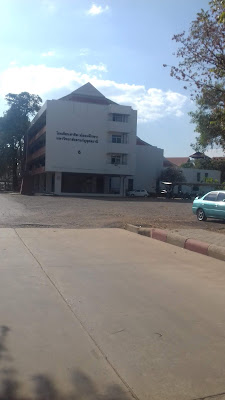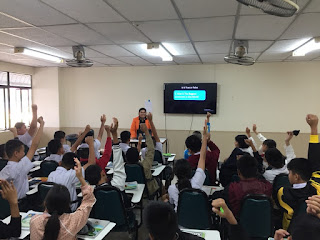1. School: General Information and Academic Administration
1.1 School Profile
The
Demonstration school of Udon Thani Rajabat University is located in Udon Thani
Rajabat University 64 Thaharn Road, Muang, Udon Thani Thailand. The
Demonstration school of Udon Thani Rajabat University was founded in 1993 by
Faculty of Education in Early Childhood section. In 2009 the school provided in
Primary section, and this year they have grade 7. Now the school is a
comprehensive middle school enrolling 429 students in Preschool-Low Secondary
level by having Assitant Professor Dr. Rewanee Chaichaowarat as the school vice
director. The Demonstration School of UdonThani Rajabat University is
accredited by the Higher Education Commission.
1.1.1. Vision
The
Demostration School of Udon Thani Rajabat University is aimed to be the
institude of the best practices for enhancing capacity of all learners so as to
attain school identities that acceptance of the social with national education
standards and quality in 2015-2019.
1.1.2. Principles
a. Development
a child-centred education approach.
b. Development
and improvement he administration system and service that are up to dare,
reveal, standard and according to university system.
c. Creating
the comfortable and safe environments that supported learning acquistition .
d. Promotion
and encouragement all of teachers and educational personnel to acquire
knowledge, skills and work as a professional.
e. Development
positive relationships between the community involvement and the school.
1.1.3 Goals
a. Learners
attain desirable characteristics following the school’s identities and
uniqueness.
b. Providing
the academic research and innovation to supported the educational system.
c. Providing
a comfortable and safe atmosphere for learning.
d. The
school can rely on itself depent on the strong administrative and organizational
system, learners and personnel with happiness, stability and quality of life.
e. Being
the learning centred and provides necessary educational and technology support
services for community.
1.2 Education Levels
1.2.1. Early Childhood
Based
on the Early Childhood Curriculum, the school is designed for developing young
children from two to age five. This is based on an approach of taking care of
an enhancing the child’s learning process which is responsive to each
individual’s nature, development, and potential. Our gold for educating
children under three years of age emphasizes all areas of a child’s
development: ohysical, emotional, social and cognitive. It is based on age,
ability, interest and individual differences in order to support children in
developing desirable characteristics.
1.2.2. Primary Education Level
(Primary Education Grades 1-6)
This
level covers the first of compulsory education. It focuses on acquiring various
skills reading, writing, calculation, fundamental thinking, communication,
social learning process and fundamentals of human being as well as complete and
balance development of quality of life in various respects physical,
intellectual, emotional, social and culture with emphasis on integrated
learning management.
1.2.3. Lower Secondary Education
Level (Lower Secondary Education Grades 1-3, Also Known As Grades 7-9)
This
leves covers the last stage of compulsory education. It focuses on allowing
learners to explore their apitudes and interests, promoting development of
individual personality, skills for critical and creative thingking,
problem-solving, life skills and skills required to apply technologies as
learning tools, social responsibility, proper a foundation for future
livelihood or further education.
1.3 Academic Support System
Satit
school have facilities that support learning activities such as:
1. computer
laboratory
2. foodball
fields
3. library
4. sport
vanues
5. science
laboratory
6. multimedia
room
7. music
room
8. multiporpose
Building
9. multiporpose
garden
1. playground
1.4 Teaching System
a. Classroom
Based Strategies
Teachers continually monitor
student performance and learning needs, and then adjust what they teach or how
they teach to improve student learning.
b. After Hours strategies
In which the school provides after school program and
tutoring services to help students prepare for class.
c. Teaching and Learning Strategies
Is when the teacher focuses on students solving
problems and perceived as meaningfull or relevant in their lives.
d. Vacation
Break Strategis.
The school provides
summer program to create and help students catch up (if they fell behind durung
the previous year) and prepare for the next grade. And also arranges the
similiar support programs for teachers.
e. Outside
of School Strategis.
The school provides a
variety of programs, such as reading programs for young children that are
connected to what students are learning in school, community groups and
volunteer based learning programs. The students also have the field every
academic year.
1.5 Materials and other Learning Sources
The school also provides various materials and
learning resources such as:
- text books
- films
- plays
- multimedia
- digital learning resources
- lectures
- speeches performances; and
- authentic materials.
1.6 Meansurement and Evaluation System
The school provides various tools in measuring or
evaluating the students learning. It also provides activities that would let
the students showcase their strength and talents in different areas of learning.
The measurement and evaluation system of the students can be through weekly
test, quiz, periodical examination (middle term and final term examination),
and also from the attitude of the students in the school.
1.7 General Curriculum.
The
basic education core curriculum is aimed inculcating among learners the following
five key competencies
1. Communication
Capacity
Capacity to receive and
transmit information, linguistic and skills in expressing one’s thought,
knowledge and understanding, feelings and opinions for exchanging information
and experience, which will be benefical to oneself and society, negotiation for
solving or reducing problems and conflicts; ability to distinguish and choose
whether to receive or avoid information through proper reasoning and sound
judgement; and ability to choose efficient methods of communication, bearing in
mind possible negative effects on oneself and society.
2. Thinking
Capasity
Capacity for
analytical, synthetic, critical, and systematic, leading to creation of bodies
of knowledge or information for judicious decision making regarding individual
and society.
3. Problem
Solving Capasity
Capacity to properly eliminste
problems and obstacles, based on sound reasoning, moral principles and accurate
information, appreciation of relationship and changes in various social
situations, ability to seek and apply knowledge to prevent and solve problems
and ability for judicious decision making bearing in mind possible negative
effect on oneself, society and the environment.
4. Capacity
for Applying Life Skill
Capacity for applying
various in daily life, self learning, continuous learning, working and social
harmony through strengthening of happy interpersonal relationship, elimination
of problems and conflicts through proper means, ability for self adjustment to
keep pace with social and enviromental changes, and capacity for avoiding undesirable
behaviour with adverse effect on individual and society.
5. Capacity
for Technological Application
Ability to choose and apply different
technological, skills in application of technological processes for individual
and society in regard to learning, communication, working, and problem solving
throught constructive, proper, appropriate, and ethical means.
The
basic core curriculum has therefore prescribed the following eight learning
areas:
1. thai
language
2. mathematics
3. science
4. social
studies, religion and culture
5. health
and pysical education
6. art
7. occupations
and technologi
1.8 Teaching Plan
The
teacher will make the lesson plan based
on the curriculum guide. My cooperating teacher taught in 3 classes in junior
high school then he would make a previous learning plan and choose the media
and teaching methods that were in accordance with the material to be taugh. he
uses different media and teaching methods based on the material he will teach
students. for example, he will show videos and maps when he teach about
geographical conditions in various parts of the world.




Komentar
Posting Komentar